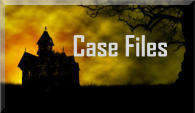HAUNTINGS AND THE HUMAN CONDITION:
WHEN GHOSTS MAY NOT BE THE ANSWER - PAGE 3
AND JUST BECAUSE YOU CAN’T HEAR IT, DOESN’T MEAN IT’S NOT THERE
“Lightning makes no sound until it strikes.”
- Martin Luther King, Jr.
Thousands of people living near wind farms are reporting
falling ill. Could there exist a by-product of their residual effects
that has less to do with the power they generate and more about
the undetected sounds that emanate from them?
In the early 1980s, an engineering designer named Vic Tandy
(pictured) was working for a company that manufactured medical
equipment. There were two other people sharing the lab space
with him which was a room about 10’ wide and 30’ long with one end closed off by doors with a window on
the other. The company he worked for made intensive care, life support equipment and it was not unusual
for a piece of equipment to be running while they worked. When Tandy heard stories from staff about the
lab being haunted, he attributed it up to the noise emanating from these machines and didn’t take the
reports seriously.
One morning, he arrived at work and ran into the cleaner who was leaving the building. She claimed she
had seen something and was quite upset about her experience. Tandy noticed the equipment was not
running at this time, so this piqued his curiosity about the origin of the claims in this location. Nonetheless
while puzzled, he maintained the source of all the activity must have a reasonable explanation. This
changed as time went on when Tandy himself began to have some odd things happen to him. There were
feelings of depression, cold shivers and a co-worker who turned to speak to Tandy who at the time was not
seated beside him despite his colleague’s insistence that he was. Something was not right in that lab, but
the staff generally went about their business and put it all out of their minds.
Then one night Tandy was alone working late when he began to feel very uncomfortable. He began to
perspire and the feeling of depression returned along with a sense that he was not actually alone. He
checked for things like gas leaks, but found nothing that could affect him like this. He took a break to get a
cup of coffee and returned to his desk where he began writing. The feeling of being watched returned again
and to make matters worse, out of the corner of his eye he saw a gray figure silently moving to his left. The
hairs of his neck stood up and he felt an accompanying chill in the room. He claimed at this point he was
“terrified”. As he turned to face the intruder, it completely vanished. Though shaken, he dismissed this as a
trick of the mind and went home for the night.
Tandy was an avid fencer and the following day he was preparing to enter a competition. He was busy
working on the handle of his foil and using the vice on his work bench to stabilize it. He walked away from
the bench for a minute to get something and when he returned he noticed the blade vibrating up and down.
Now he began to wonder if in fact there was a ghost in his work space. It was at this point that his
engineering background came into play. Knowing that energy was being transferred into the blade equal to
the resonant frequency of the blade, he determined it was being manipulated by sound. Placing the foil in a
drill vice, he slid the stand along the floor and halfway through the room, level with the desk, the vibration
increased. As he continued sliding the drill vice, the vibration decreased the further from the desk he got
until it completely stopped at the other side of the room. It was then he realized that somewhere in the
room was a low frequency standing sound wave meaning it was being contained within the walls of the
room.
Two questions were answered as a result of this impromptu experiment. First the sound had to be less
than 20Hz which is the lowest the human ear can discern and secondly a quick check with the building
foreman revealed a new extraction fan had been installed recently. When the fan was switched off, the
standing wave ceased to exist. It was soon discovered that other areas of the building where workers had
reported a feeling of uneasiness and it was found that all had some level of infrasound permeating that
particular area.
Sound engineers have concluded that symptoms from exposure to low frequency sound include, severe
middle ear pain, persistent eye watering, respiratory difficulties and sensations of fear including excessive
perspiration and shivering. Why does this happen? It seems the human body vibrates at various
frequencies and if those frequencies are artificially increased they can be affected adversely. The eyeball for
example vibrates at 18 Hz and the introduction of infra-sound at the level of Tandy’s lab (40Hz) would
result in the eyeball vibrating at a rate that would severely distort vision. As peripheral vision is
monochromatic meaning we see out of the extreme corners of our eyes in black and white. this goes a long
way to explain not only what Tandy saw, but what most people might be describing when they see dark and
blurry figures out of their peripheral vision.
Tandy would go on to investigate other reputedly haunted locations and, using sensitive sound meters,
found that in many cases infra-sound was present. Tandy passed away in 2005 at the age of 50. Films like
Paranormal Activity have used infra-sound as a means of installing fear and discomfort in theater goers.
EVOLUTIONARY FACTORS/”FIGHT OR FLIGHT”
“Even though we may not always be aware of danger on a cognitive level, on a neurophysiological level,
our body has already started a sequence of neural processes that would facilitate adaptive defense
behaviors such as fight, flight or freeze. ”
- Stephen W. Porges, The Polyvagal Theory
Beyond the mind’s ability to visually detect potential
threats from ambiguous shapes (pareidolia), there is
another way we protect ourselves from possible threats
and it’s called “agency-detection mechanisms” and they
might help explain why people have paranormal
experiences in some locations but not others. Here’s how
it works:
When you are in a situation where you are in a
compromised or vulnerable position - for instance walking
down a poorly-lit street or through a dark and unfamiliar
room - and hear the sound of something moving beyond your field of vision, your physical and
psychological response will be that of a heightened sense of arousal and focused attention as there is a
psychological perception that the sound may originate from some manner of assailant intending to do you
harm. This is a perfectly normal and healthy response to a stimulus that has three possible outcomes.
In the first and most positive outcome, the sound reveals itself to be nothing more than a gust of wind
or perhaps a harmless animal and you continue on your way with your fears quelled. The second outcome
is that your fears are realized and the sound is indeed caused by an attacker in some form and your
heightened alertness and anticipation of danger allows you to escape unharmed. The third and most
disturbing result is that your ignore all warning signs and an attacker is successful in doing you harm.
As we have evolved, we have learned not to ignore possible peril to our well-being and tend to err on
the side of caution when faced with potential threats and unsettling circumstances and this is often
accompanied by a heightened sense of anxiety and a predisposition to anticipate something unusual
occurring, especially where there is a strong suggestion already in place that there is a likeliness of it
happening (i.e., you have been pre-informed you are in a notoriously haunted location). A 2013 study done
by Kirsten Barnes and Nicholas Gibson sought to distinguish differences between individuals who claim to
have had a paranormal experience and those who claim to have not. Their conclusion was that reported
experiences of a paranormal nature tend to occur in places that are more threatening, unfamiliar or
mysterious and that those who claimed a paranormal experience tended to apply deeper meaning to what
might be otherwise ordinary and superficial occurrences.
ANTHROPOMORPHISM AND PROJECTION OF
RESPONSIBILITY
“We find human faces in the moon, armies in the clouds; and by a natural propensity, if not corrected by
experience and reflection, ascribe malice or good-will to every thing, that hurts or pleases us.”
-David Hume, Natural History of Religion III
Often when tragedy or misfortune strikes, humans - or more specifically the human mind - will seek
meaning and understanding amid the turmoil. In such situations we sometimes seek to exert control over
matters that are distinctly out of our control. When that doesn’t happen through rational thought, we can
fall victim to creating a form of alternate reality for ourselves and assign patterns and significance to
otherwise random events or combine multiple unrelated things like “knocking on wood” and good fortune as
a method of achieving control over our lives
Anthropomorphism concerns the attribution of human traits to decidedly non-human entities. The most
common example is projecting human personality characteristics onto
animals in regards to their behavior in a given circumstance, but we
often see it displayed in terms of the paranormal as well. In one
scenario we see quite often, an individual or group of individuals will
claim that a pattern of adversity is related to supernatural forces at
work as they endeavor to come to terms with their unhappiness. The
classic example is the family who moves into a new home and without
warning the husband loses his job, or his wife falls ill and the children begin to exhibit more aggressive or
defiant behavior. What brought on these unforeseen changes? In attempting to find an explanation for their
sudden reversal of fortune, they might find the easiest form of justification for the upheaval in their lives
lies with moving into the new house. Before that seminal event, all seemed well.
We see in these cases that for some predisposed to believe in the paranormal, it becomes easier to
assign responsibility to mystical forces within their new home than accept the sheer random nature of the
events. Each individual circumstance soon become connected to form one all-encompassing episode. The
potential danger in this is the dismissal of personal accountability for one’s lot in life or more specifically, an
increasing reluctance to fight through adversity and improve the situation as a growing sense of
hopelessness and resignation falls over them. In a perverse twist, it becomes more satisfying to believe you
have indeed found the answer to your problem than acknowledging that sometimes we lack control over
incidental forces that affect us. Our minds are wired to seek explanations for aberrant events, even if the
solution is there exists no rational explanation.
In these situations, people will often seek out like-minded individuals to support their claims and this
factors into the decision to invite in paranormal groups who they believe might be more prone to aid and
abet their world views. At times, there becomes a sort of unspoken pact that the group will co-sign their
observations and conclusions and often willingly do so with the absence of objectivity in order to gain
access, exert control/influence and ultimately trumpet their own accomplishments. Those who remain
critical in their thinking - or offer alternate reasoning - are often summarily dismissed as not knowing what
they are doing or accused of casting doubt on the character of their client. It is not unusual for
experiencers to call in a number of groups before they find one who will tell them exactly what they want to
hear.
MAGICAL THINKING
“Reality is that which, when you stop believing in it, doesn’t go away.”
-Philip K. Dick, Science Fiction Author
Some people are naturally inclined to see hidden patterns or motives in random events. Believers in the
paranormal have difficulty understanding why others do not feel what they feel, see what they see or
believe what they believe and this can also be applied to skeptics as well to some degree. So it begs the
question, what makes believers and skeptics who they are? There is a possible answer to this and it
involves something called “cognitive inhibition”. In simple terms it’s the ability to push aside unwanted or
unreasonable thoughts and it might be stronger in skeptics than believers. It’s often said skeptics are those
who have not yet had a true paranormal experience and speaking as someone who believes he’s had a few,
there is merit in that statement, but as we are supposed to remain objective, we need to look a bit deeper
and cite some examples.
All of us at one time or other have found our thoughts drifting to someone and within minutes our
phone rings and it is that person calling us. While some people accept this as an amusing coincidence
each time it happens, share their surprise with the caller and move on, others tend to focus on such
occasions more intently and for a much longer period of time. Rather than accept such things as inevitable
and not take into account the hundreds of other calls taken and placed in-between such incidents, a point
of emphasis remains on that call. If and when at some point in time the coincidence repeats itself, a pattern
is assumed. Should it happen 3-4 times a year out of 1,000 calls and texts it is declared that, “It happens
to me all the time” and the assumption of some form of telekinetic or psychic power is offered as an
explanation. Everyone gets a little freaked out by weird coincidences and patterns on occasion (the clinical
term for the ability to connect random patterns and events is called apophenia), but it seems some people
can more easily work past them than others. Studies have shown that believers in the paranormal are more
prone to stick by their beliefs even if the factors that contribute to them are ambiguous at best. This can
also be applied to conspiracy theorists as a feeling of uncertainty can trigger the brain’s ability to identify
illusory patterns even in the otherwise most banal of circumstances.
It’s easy to imagine weird things happening when we feel unsure and unsettled in a given situation.
Even when we are in an otherwise positive and hopeful place we often harbor doubts of the future as we
consider happiness and hope to be fleeting emotions which can also result in an increase of belief in the
paranormal and/or conspiracy theories. It’s all based on the brain’s ability to spot illusory patterns and even
the most rational among us are susceptible to flights of fancy from time to time.

































